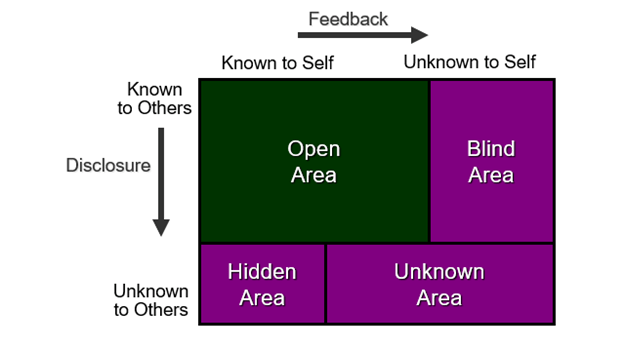The step toward digital learning focuses on the need for resources that promote both academic success and personal growth. The Johari Window, introduced by Joseph Luft and Harry Ingham in 1955, stands out as a method for enhancing self-awareness and interpersonal communication, essential in navigating the difficulties of online learning. This model helps people understand their interactions and perceptions, both self- and society-related, by breaking personal perception down into four quadrants: Open, Hidden, Blind, and Unknown.
The importance of the model is demonstrated by applying it in education, especially through learning analytics and personalized tutoring systems. Employing methods like library usage and online activity, universities like Nottingham Trent and Greenwich use it to give feedback on student engagement. By adopting the impersonal character and restraints of digital engagement, this feedback loop helps resolve obstacles that challenge the way of successful communication and building trust joint in virtual classrooms. Hence, The Johari Window presents a viable strategy for improving virtual learning opportunities.
In consequence, students will have a better perception of the way they express themselves in virtual places by searching the open quadrant and cultivating self-awareness. Obtaining habits and attitudes that support more effective and constructive online interactions needs understanding of this. In a similar vein, the blind quadrant promotes a sense of useful criticism, allowing instructors and students to identify and resolve actions that might be holding back their online contribution.
The Johari Window’s impact covers the Hidden quadrant, where exposing one’s own conflicts and experiences can enhance the development of stronger, more positive online communities. We connect by sharing our weaknesses, which helps shorten the distance that digital communication commonly causes. Both students and teachers can explore the Unknown quadrant to find new attempts and educational opportunities that will inspire curiosity and a desire for persistent development.

There are several benefits for using the Johari Window in digital learning environments. The concept creates the foundation for an online learning community that is more self-aware, supportive, and consistent through better communication skills and increased emotional intelligence. In the digital age, these attributes are needed for productive teamwork, collaboration, and academic achievement.
Applying digital platforms for reflective journaling, creating online feedback systems that promote productive criticism, or employing virtual ice-breaker activities that stimulate personal sharing are all easy methods to include the Johari Window into digital learning approaches. The secret is to establish a secure and encouraging environment where students can freely explore all aspects of their personalities while using the Johari Window’s insights as a guide.
To sum up, the Johari Window has the potential to change virtual learning settings into places where communication, emotional intelligence, trust, and self-awareness are supported. Teachers and students alike can productively and more confidently negotiate the challenges of online learning by adopting this model. Let us use the Johari Window’s capacity to discover the potential hidden in our digital learning settings and promote a culture of understanding, growth, and connection.
Please feel free to contribute to the comments area below about your experiences employing the Johari Window and digital learning. What effects has it had on how you see yourself and how you interact with other people? Participate in the discussion and let us explore the endless possibilities together.





Great article. In today’s rapidly evolving digital landscape, harnessing the full potential of digital learning environments is imperative for both educators and learners alike. The Johari Window, a powerful psychological tool originally devised to facilitate interpersonal communication, emerges as a beacon of insight in the realm of digital education.
Thank you for your kind words! I completely agree that integrating tools like the Johari Window in digital learning can greatly enhance understanding and communication in the educational landscape.
Johari Window Theory, a concept that has proven to be a valuable tool for self-discovery and personal development. This theory, developed by psychologists Joseph Luft and Harry Ingham, focuses on the importance of understanding oneself and how others perceive us.I believe that incorporating the principles of the Johari Window Theory into our online learning practices can lead to a deeper understanding of ourselves and our peers, ultimately fostering a more collaborative and supportive learning community
I would like to extend my gratitude to Dr. Marwan for sharing his insights on this topic and for highlighting its relevance in our professional and personal lives.
Thank you for your insightful comment. I agree that applying the Johari Window Theory in online learning can significantly deepen our self-awareness and improve collaborative environments.
I would like to delve into the concept of the Johari Window and its implications on digital learning environments. As individuals who are likely navigating various online platforms for education and professionaldevelopment, understanding the Johari Window can provide valuable insights intoour interactions and relationships in these virtual spaces. In the context of digital learning environments, the Johari Window can offer insights into how we present ourselves, receive feedback, and build relationships with peers and instructors. By understanding our own self-awareness and perception, we can better navigate online discussions, collaborative projects, and feedback mechanisms. Additionally, recognizing the blind spots in our self-awareness can help us identify areas for personal growth and development in a virtual setting. At the end I extend my heartfelt thanks to Dr. Marwan for his outstanding contribution.
Thank you for sharing your thoughts on the Johari Window’s relevance in digital learning. Your insights on how it enhances self-awareness and interpersonal dynamics online are invaluable.
Great job. The Johari Window is a powerful platform or tool to facilitate interpersonal communication in digital education; I think incorporating the Johari Window Theory into our digital education practices can ultimately foster a more successful one.
Thank you very much, Dr. Marwan Milhim, for sharing your insights on this topic and highlighting its relevance to our daily lives.
I really appreciate your positive feedback and support.
Thanks Dr.Marwan for your effort and grade information
Thank you Dr.Marwan for your great job
Thanks again for your kind words
Thank you so much for taking the time to comment on my blog post.
Dear Dr Marwan ,
I wanted to take a moment to express my sincere gratitude for introducing us to the Joihari Window concept . Your knowledge and expertise on the subject were truly impressive, and it was enlightening to learn more about this innovative approach.Once again, thank you for your valuable contribution and for taking the time to enlighten us on the Joihari Window concept. Your passion and dedication to this subject are truly commendable
Thank you so much for taking the time to share your thoughts on my blog post.
This article beautifully integrates the concept of the Johari Window with digital learning environments, offering a fresh perspective on how we can unlock hidden potential in education. Looking forward to seeing more insights on this intersection. Education becomes a catalyst for personal and societal metamorphosis.
Thanks for your kind words
Such an interesting concept!